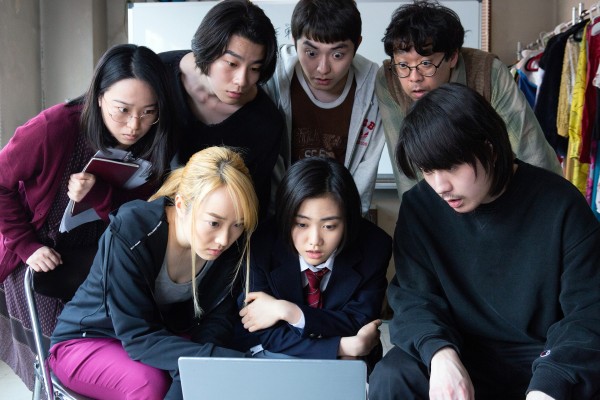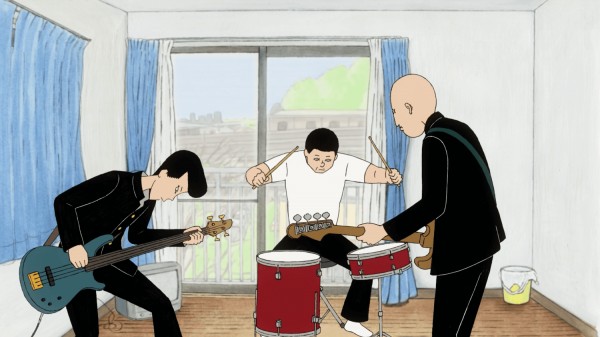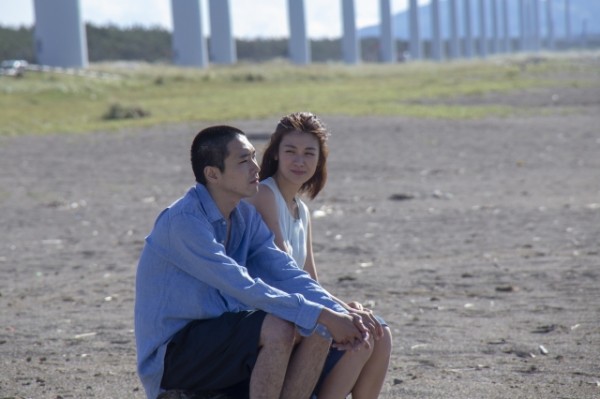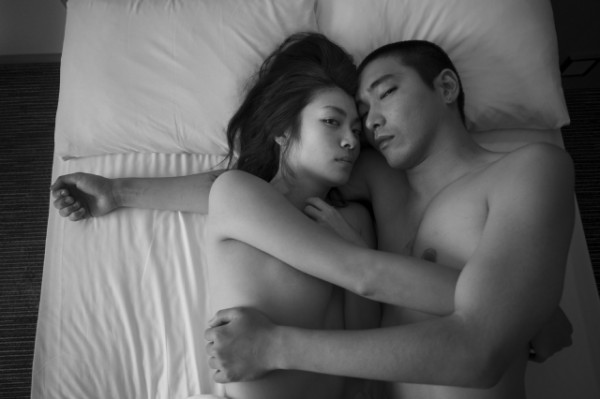-
JAPAN CUTS all-online edition July 17-30, 2020 REVIEWS
Last edited by Chris Knipp; 07-30-2020 at 06:56 PM.
-
EXTRO (Naoki Murahashi 2019)
NAOKI MURAHASHI: EXTRO/ エキストロ (2019)

Rank and file on set
On the lot of "Warp Station Edo," a popular shooting location for historical jidaigeki (period dramas), a camera crew follows several extras as they prepare for and perform their non-speaking roles as anonymous townspeople behind sword-wielding stars. In particular, they focus on a sixty-something former dental technician and part-time farmer in Ibaraki Prefecture, Kozo Haginoya (Kozo Haginoya) whose current ambition is to follow in the footsteps of his idol Steve McQueen - who, he most remembers, was a fireman in The Towering Inferno. Comically, Kozo's eagerness winds up causing multiple delays and reshoots of scenes. At one point he collapses with a stomach ache just as the samurai hero (Koji Yamamoto) is uncovering a dead body - an action he is forced to repeat over and over.
This cameo-filled mockumentary is a good-natured sendup of the Japanese film industry that is simultaneously a tribute to the essential role played by the extras who create the atmosphere and emotion that add up to the sense of realism behind a scene.
The title comes from ninety-something filmmaker Nobuhiko Obayashi, who appears bookending the film and concludes by saying, "To me, extras are... Maestros." Hence the titular "extro," a portmanteau blend of "extra" and "maestro."
Much of the action is funny but low-keyed. A key sequence comes when examining the rushes of a film some detectives notice one extra is a real-life drug dealer. Two undercover cops are sent in to play extras. They think their work will make acting easy, but in fact, they are horrible at it, occasioning a series of ridiculous bad takes. As one or the other of them reacts too little or too much to a filmed situation. Their irritating goofs send a macho star (Tatsumi Fujinami) storming off the set.
Mark Schilling of Japan Times thinks the spirit of this film resembles Ueno's 2017 hit (NYAFF 2018) One Cut of the Dead. Both movies play around freely with fake filmmaking.
Extr0, 89 mins., debuted apparently in Japan in March 2020. It was shown in July online as part of the Japan Cuts 2020 virtual edition, where it was screened for this review.
Last edited by Chris Knipp; 07-24-2020 at 09:19 PM.
-
VOICES IN THE WIND (Nobuhiro Suwa 2019)
NOBUHIRO SUWA: VOICES IN THE WIND 風の電話 (Kaze no Denwa 2019)

SERENA MOTOLA IN VOICES IN THE WIND
A girl at last confronts her grief, long after Fukushima
Nobuharu Suwa, whose last movie starred Jean-Pierre Léaud, has been working in France for eighteen years "because of the French funding system, which supports directors." He returned to Japan for The Wind Telephone (the original title). A man put a white phone booth on the top of a hill in Otsuchi with a disconnected rotary phone to speak to his dead brother. Then a year or so later, Fukushima happened, and this was in the heart of it, ten percent of the population killed. The phone became a place where thousands came to engage in symbolic communication with love ones lost in the 2011 earthquake, tsunami, and nuclear disaster, in which 18,500 were killed or disappeared and 160,000 lost their homes. It becomes the destination of a new journey, followed in this film.
Suuwa's road trip, a series of heartfelt scenes with largely improvised dialogue, follows Haru (the excellent Serena Motola, previously more known as a fashion model), a seventeen-year-old girl who lost her whole family in the tsunami when she was nine. She has been living in HIroshima (incidentally Suwa's home town) with her Aunt Hiroki (Makiko Watanabe). But when that aunt collapses on Haru's first day of her senior year of high school and winds up in the hospital apparently in a coma, it brings back all the sorrow and loss to Haru, and she runs away - back home - in search of her parents and in confrontation of her grief.
Hiroshima itself was seriously damaged by heavy rains in 2018, which caused over 1,200 landslides. The first man who helps the now lost, mute Haru is a worker with an aging mother who barely survived these.
Initially Haru is silent as a stone, but certain things gradually bring her out. First among these is the senile mother of the man who rescues her collapsed on a road, who takes her hand and speaks to her, remembering her experience of the atom bomb as a child, and still ashamed at her curiosity about the bones of a loved one. Then, when Haru hitchhikes, a bearded man and his pregnant sister pick her up. They take her for a good restaurant meal and later, the mother lets Haru feel her baby stirring inside her, which causes her to speak.
By coincidence, a man who then rescues her from marauding teenage boys is Morio (Hidetoshi Nishijima), a devastated former nuclear worker now living in a van who himself lost his family in Fukushima's destruction. He consents to take her back home, on a circuitous route through Tokyo. Morio is searching for a Kurdish refugee who, after helping with the Fukushima cleanup, has been detained as an alien. (As Hadfield 's Japan times review points out, this film is also "concerned with the idea of home".)
Unlike the bland Fukushima 50, this often mute film speaks out against the bad handling of the disaster through the legendary Toshiyuki Nishida, who cries out against the discriminatory treatment of locals and the nuclear firm TEPCO's failures and corruption.
From the beginning, Suwa gets at something elemental and cinematic beyond scripts and scores, a kind of intense, pure experience. The statuesque Motola is basic to this, her mysterious, Garboesque silence, her sad eyes, her lightly freckled face.
Among the many cinematic statements about Fukushima 3/11 from Japan this is one that's memorably authentic and moving because it's so simple.
Voices in the Wind / 風の電話, 140 mins., debuted internationally Feb. 2020 at Berlin (reviewed there by Gavin Blair for Hollywood Reporter) and featured at Taipei Jun. 2020.. It opened theatrically Jan. 2020 in Japan. Screened for this review as part of the all-online 2020 edition of New York's Japan Cuts festival.
_________________________
The festival is entirely online this year. Anyone in the US can watch it, paying a small fee for each individual film, from July 17-30, 2020. Go HERE to access the films.
Last edited by Chris Knipp; 07-31-2020 at 02:10 AM.
-
SPECIAL ACTORS (Shin'ichirô Ueda 2019)
SHIN'ICHIRÔ UEDA: SPECIAL ACTORS / スペシャルアクターズ (2019)

SOME OF THE CAST OF SPECIAL ACTORS
Siblings and simulations
Kazuto (Kazuto Osawa) is a lonely loser, owing rent on his little flat and failing in acting class due to emotional weakness: he faints whenever he feels stressed, which is almost constantly. Squeezing a "boob" hand exerciser helps only a little; he gets likewise little help from constantly watching an old videotape of a crude dubbed TV show called "Rescueman." Then Kazuto runs into his younger brother Hiroki (Hiroki Kono), from whom he's been estranged for the five years since their parents died. The handsome, confident Hiroki was supposed to be starting his own company but he too is a thespian of a sort. The "Special Actors" team to which he takes Kazuto offers actors for hire to tweak or simulate situations on request of paying customers, to alter situations. They can, say, provide a "thief" a boyfriend can "subdue" to impress his girlfriend.
Kazuto starts easy - crying at some relative's wake, laughing at somebody's comedy show. Then a more challenging and more lucrative job comes along that requires the participation of the entire Special Actors team. A girl offers her entire savings for them to shake up a crooked pseudo-religious cult called Musubiru that has charmed her sister and is about to take over the country inn they inherited from their parents. They must infiltrate the cult and expose it so the sister will leave the cult and hold onto the inn.
This project occupies most of the rest of the movie. In fact, the opening credits don't come till 25 minutes in, a sign of Ueda's characteristically sly, self-reflective approach in Special Actors which, though smoother and more conventional (and perhaps more heartwarming?) than his famous first
feature, likewise relies on the comedy of clumsiness, on the "real" effect of an illusion that's inadequate. Aren't bad actors the best people to play (real) bad actors? That's his assumption, anyway.
The Musubiru cult winds up being a crude but memorably nightmarish version of charlatans exploiting the gullible whose "secret plan" the actors capture and expose. It's hard to forget the zillion-year-old "leader", a tall, "mute" boy with permed hair; the shrill shills in suits; the cheap souvenir gizmos sold for outrageous prices; the odd hand gesture of cult greeting, and the rest. Even if the scenes lag a bit in the middle, Ueda shows the same penchant for raucous, chaotic action he used so well in his first film.
Burt of course though Special Actors is both entertaining and ingenious, it arrives with an impossible act to follow - Ueda's 2017 hilarious surprise hit debut One Cut of the Dead (whose Japanese title means "Don't Stop the Camera!"), which famously made something like a thousand times what it cost to make, having been a runaway hit in 250 theaters in Japan and earned $30 million abroad on a $25,000 investment. So we have sophomore blues with Special Actors and no, it's not as brilliant or as outrageously fun as One Cut of the Dead.
But some have been overly disappointed, like James Hadfield in Japan Times. I don't think as some do that the surprise ending is obvious; on the contrary, the deception-within-deception effect is quite trippy - even if this movie may be a tad more interesting to think about than to watch. The whole theme of using amateurish actors for "useful" deceptions in real life is wonderful.
It's also fun as one can learn in detail from the Japanese Wikipedia article on this film that the Ueda's screenplay development involved extensive workshopping with all the 15 core cast members involved plus several more, incorporating the actors' ideas and personalities more deeply into the action. Those cast members included people who'd acted three times in ten years (Kazuto Osawa, the bedraggled "lead"), other's who had not yet acted, still another who was just an office worker who was a big fan of One Cut of the Dead. The tendency to pass out under stress - almost anyway - was taken from the young (36-year-old) Ueda's own reported experience.
Opening Film. Live Q&A with director Shinichiro Ueda scheduled for July 17 at 9 pm (ET).
As mentioned I've used the Japanese Wikipedia article as a source using DeepL and found it quite helpful; it's hard to find a cast list elsewhere. There are numerous reviews in English listed on IMDb (see allso Letterboxd).
Special Actors109 mins., premiered in Japan September 25, 2019 and [I think] debuted at Rotterdam Oct. 2019. Opening night film for the all-online New York Japan Cuts 2020, via which it was screened for this review.
Last edited by Chris Knipp; 07-24-2020 at 03:06 PM.
-
ON-GAKU: OUR SOUND (Kenji Iwaisawa 2019)
KENJI IWAISAWA: ON-GAKU: OUR SOUND (2019)

Noise rock
Kenji Iwaisawa's feature debut is an offbeat one-hour animated film that adapts Hiroyuki Ohashi's manga about some aimless high school delinquents who find, momentarily anyway, a sense of purpose in forming a three-man rock band. It's primal. He teases us with the minimalism of these guys who are ageless and almost faceless and are monosyllabic and sometimes just sit there silent. Kenji (voiced by former Yura Yura Teikoku frontman Shintaro Sakamoto) is the leader of sidekicks Ota (Tomoya Maeno) and Asakura (Tateto Serizawa). There are some skinheads who hate but fear Kenji. When they meet, it's at a "comic cafe."
They make a mistake, and wind up with two bass guitars, accompanied by drums. They do not know how to play. That has not gotten in the way of some rock bands. I am indebted to the enthusiastic review by James Hadfield in Japan Times ("an instant classic"; "seven years in the making") for details such as the explanation why the band's choice of name is a problem. They pick "Kobujutsu" (classical martial arts) and the school already has a "Kobijutsu" (classical arts). Kenji tries to stare down the leader of Kobijutsu and make her change their name.
The "music" of Kobujusu just sounds like noise. That is, the climactic concert. Morita (actress Kami Hiraiwa), the director of Kobijutsu, invites Kobujutsu to participate in what's reportedly one of the first rock festivals in Japan. They agree.
In the event, there are surprises, first of all in the instrument Kenji shows up with - and his showing up in itself is a surprise, since he has declared himself "bored" with the band after a preparatory recording playback on a tiny Walkman displeases himi, and walked away. Then, there is the participation of a musician from another band with much greater skill. The mix of odd, primal, and skillful makes for the kind of cosmic explosion that is needed to make this story turn from deadpan to almost exultant. Yes, this is an unusual film. Hadfield says it's all hand-drawn, a reason for the long time in preparation; also as he oints out there's some use of rotoscoping in the final performance sequence to make the moment come alive.
On-Gaku: Our Sound, 71 mins., debuted at Ottawa Oct. 2019; several other festivals. Limited theatrical release in Japan Jan. 20220. Secreened for this review as part of Japan Cuts, New York, July 2020.
Last edited by Chris Knipp; 07-25-2020 at 10:45 PM.
-
IT FEELS SO GOOD (Haruhiko Arai 2019)
HARUHITO ARAI: IT FEELS SO GOOD 火口のふたり (2019)

TASUMI EMOTO AND KUMI TAKIUCHI IN IT FEELS SO GOOD
A feast of sensuality and self discovery
Terrible English title aside (the Japanese film's name is "Two at the Crater"), this new feature by Haruhiko Arai based on the prize-winning novel of Kazufumi Shiraishi is fresh, original, and jaw-droppingly sexy. It's a two-hander, a lot of its success inevitably hence owed to Kumi Takiuchi as the woman, Naoko, and Tasuku Emoto as Kenji, the boy (now grown up, some, and divorced) with whom she had an intense sexual affair when they were very young. Naoko is about to marry a Self-Defense Forces colonel who's still away working. She's back in her hometown, Akita, for the wedding and finds Ken is back for the event at the house of his late mother, which is unused. What she proposes as a last 24-hour fling, despite his strong initial resistance morphs seamlessly into a five-day marathon.
And boy do they get it on. James Hadfield of The Japan Times describes this aspect well. He points out Arai, a screenwriting vet on his third directorial outing, was "seldom coy" about sex, but this time is so enthusiastic it "harks back" to his "earliest work" on "sofcore Nikkatsu Roman films." As he points out, "beds, baths and kitchen tables aren't safe and on a road trip they even "manage to get off" while "staying on a bus." But the conversation in between becomes as Bergmanianly intense and searching as the sex. There is something exhilarating about this fluent, elemental orgy of physicality and honesty, even if the ending, which feels over-thought, loses much of the conviction and zing of what's gone before and would have been better ruthlessly shortened.
At its best the film is relaxed and natural, as sex should be, and as the two leads are. Kumi Takiuchi and Tasuku Emoto aren't like porn stars or glamour-pusses. They're fit, lean, and ready. more like dancers or athletes. They're loose, at ease in their bodies and at ease with each other's bodies. The best action part is the early sequence where they move together from house to car to ramen shop as they get reacquainted and he resists. He plays this well and the attention is on him. The weakness is that the dialogue here is so blatantly expository. A set of arty black and white photos of the couple way back when isn't very convincing. Here and there, the score could have gone lighter on the strings. A shot of the pair now naked side by side on a bed looking out a window is classic.
They work out so hard at first there's abrasion and his penis requires a cold compress. He hasn't had sex with anyone for a while. He wasn't married long, and lost visitation rights to his six-year-old daughter. And he is out of work, only working part time. Over this hovers the disaster of 3/11 and another potential disaster disrupting Japanese lives and incomes.
The physical part of the story continues apace, and it rarely loses momentum or credibility. But the mental part, what we're offered to think about, is in the conversation in between. The sensuality is carried over into their meals. He cooks dinner for them, and every time looks delicious, though a hamburger dinner she requests makes her sick.
Of course it gradually develops that this happens because their passion was a once-in-a-lifetime thing, and that the groom's purpose is to give her a baby. (It's also a surprise to me to learn far along in the idyll that she hasn't been allowing Ken full penetration; they haven't used contraceptives.) Ken debunks the idea of marriage to have children. She is highly critical of him. She says he's never either had enough ambition nor been willing enough to take help from others.
Well along in their sex idyll, they attend a local night folk festival with lights and costumed figures all in masks. It's both beautiful and scary, and it becomes a nice objective correlative for the state of confusion they're in at this point, a nicely used bit of local color and a good relief from the bedroom-meal-bedroom round.
These chats that are so raw and direct make us wonder where things are going. Hovering over all is a time when he shifted away from her, then called and begged her "Die with me." They went to the edge of Mount Fuji volcano. The image of the mouth of the volcano is a recurrent one. Naturally this movie isn't about "it feels so good," though it does feel damn good; that just isn't the whole story, and despite its outward sense of happening in a bubble of sensual bliss, it all happens very clearly in a contemporary Japan where there are all kinds of worries.
It's interesting to compare this to Renais' structurally related Hiroshima mon amour, from 1959. It may have seemed wonderful a the time, but Marguerite Duras' dialogue feels pretentious today, and the love-making in the sane, or whatever it was (which Pauline Kael made fun of) is trumped by Arai's. This movie's sex is stylized too - he doesn't show us everything. But what he shows is so explicit, you're there. It's state-of-the art movie sex.
It Feels So Good / 火口のふたり, 115 mins., released in Japan Aug. 2019; in Taiwan Apr. 2020, Hong Kong May 2020. Screened for this review as part of this year's all online Japan Cuts (New York Jul. 2020).

KUMI TAKIUCHI AND TASUMI EMOTO IN IT FEELS SO GOOD
Last edited by Chris Knipp; 08-07-2020 at 09:21 PM.
 Posting Permissions
Posting Permissions
- You may not post new threads
- You may not post replies
- You may not post attachments
- You may not edit your posts
-
Forum Rules





 Reply With Quote
Reply With Quote






Bookmarks